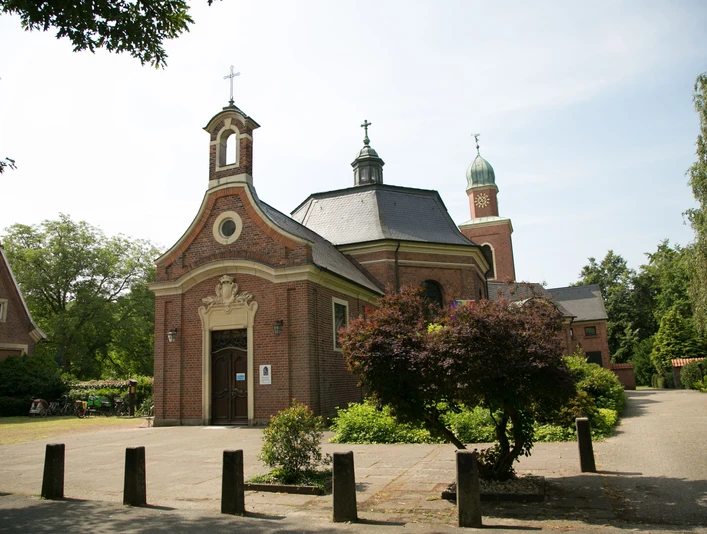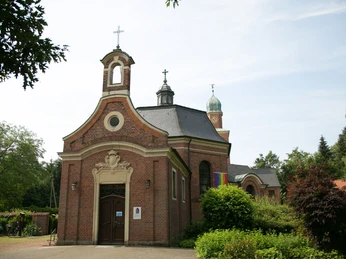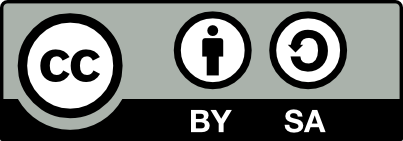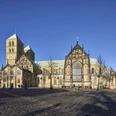The Dyckburg Church, actually St.-Mariä-Himmelfahrt, is today mostly colloquially named after its location in the district of Dyckburg near Münster-Handorf. The small chapel was built in the 18th century according to the plans of the well-known baroque architect Johann Conrad Schlaun, who also designed the castle and the Erbdrostenhof in Münster. St. Mary's Ascension Church once belonged to a small moated castle, Haus Dyckburg, of which two economy buildings remain today. The adjacent Dyckburg Forest invites you to take long walks, and the Werse River and the Boniburg Monument are also within walking distance.
- A tour of the outside of the Dyckburg Church and the adjoining buildings of Haus Dyckburg is possible at any time.
- A tour of the interior of Dyckburg Church is possible on request or as part of a church service.
Already in earlier centuries, a castle stood on the site of today's Dyckburg Church. The owner was Bishop Franz von Waldeck , who used the site mainly for military purposes. Today, only fragments remind us of this building.
At the beginning of the 18th century, the cathedral provost Ferdinand von Plettenberg had a manor house built on the former castle grounds. The architect was none other than the Baroque master Johann Conrad Schlaun, who had already worked on Münster Castle and the Erbdrostenhof. In addition to two farm buildings, a small chapel was also built, which was finally consecrated in 1740. Schlaun took a chapel building in the Marian pilgrimage site ofLoreto in Italy as his model.
After the estate, Haus Dyckburg, went to a nobleman from Münster at the end of the 19th century, the small chapel was extended by a round building as a church room and a neo-baroque choir area.
From 1949 to 2008, the Dyckburg church served as the parish church of the Dyckburg community. Since 2012, it has been affiliated with the parish of Saint Petronilla in Münster-Handorf and is regularly used for church services.
Good to know
Eligibility
for Groups
Directions & Parking facilities
Arrival by car:
Dyckburg Church is located in the north-east of Münster.
from here turn onto Dyckburgstraße
after approx. 1.5 km Dyckburg Kirche is on the right-hand side
Arrival by bus/train:
can be reached by bus 4 from Münster main station.
Get off at the Heidehof stop
walk 5 minutes from here
Parking
There is a car park at the Dyckburg Church.
More information
It's not for nothing that Münster is called the "cycling capital". Numerous cycle paths and special infrastructure make cycling in Münster a great experience. And the nice thing about it is the quick change between urban Münster and nature-loving Münsterland.
The Dyckburg Church is located just outside Münster in the countryside, close to the Werse. The baroque building can be reached quickly by bike from Münster. And there are other highlights such as the Boniburg Monument, the sewage fields near Gelmer or the historic old town in Telgte.
Various themed cycle routes offer interesting cycling tours through Münsterland. The signposted themed cycle routes each show very special contents of the region and thus tell exciting stories about Münsterland. Bocholt is also connected to various themed cycle routes.
100 Castles Route, North Course and East Course
Werseradweg
The entrance to the Münsterland cycle path network, which is around 4,500 kilometres long, is located directly on the Werse and offers numerous opportunities for great cycle tours in the region. Everyone will find a suitable cycle route here.
Author
Münsterland e.V.
License (master data)
Nearby






